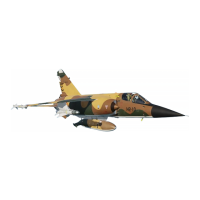
Do you have a question about the DCS AERGES MIRAGE F1 and is the answer not in the manual?
| Type | Fighter aircraft |
|---|---|
| Role | Multirole fighter |
| Manufacturer | Dassault Aviation |
| Introduction | 1973 |
| Height | 4.50 m (14 ft 9 in) |
| Max takeoff weight | 16, 200 kg (35, 715 lb) |
| Powerplant | 1 × SNECMA Atar 9K-50 afterburning turbojet |
| Service ceiling | 20, 000 m (66, 000 ft) |
| Crew | 1 |
| First flight | 23 December 1966 |
| Primary users | French Air Force |
| Number built | Approximately 720 |
| Wingspan | 8.40 m (27 ft 7 in) |
| Thrust | 49 kN (11, 020 lbf) thrust dry, 70 kN (15, 730 lbf) with afterburner |
| Maximum speed | 2, 338 km/h (1, 453 mph, 1, 262 kn) at high altitude |
| Max Speed | 2, 338 km/h (1, 453 mph, 1, 262 kn) at high altitude |
| Armament | 2 × 30 mm DEFA 553 cannons |
Overview of different Mirage F1 models and their unique features.
Details on the Spanish export variant, its service history and key differences.
Key physical dimensions, weight, and propulsion details of the aircraft.
Permissible load factors, speed limits, ceiling, and Mach number capabilities.
Detailed labeling and identification of cockpit instruments and controls across multiple panels.
Description of the aircraft's electrical system components, power distribution, and operation.
Explanation of internal and external fuel tanks, transfer sequences, controls, and indicators.
Overview of the SNECMA ATAR 9K-50 engine, its operation, controls, and indicators.
Description of the dual hydraulic circuits, their functions, controls, and failure indications.
Details on flight control surfaces, operation modes, and trim systems.
Comprehensive guide to the aircraft's weapons, selection panel, controls, and payload types.
Detailed explanation of the CYRANO IV fire control radar, its functions, modes, and operation.
Step-by-step checklist for safely entering the aircraft cockpit and performing initial checks.
Procedures for engine start-up, including pre-start checks and initial engine spool-up.
Instructions for performing a standard takeoff, including speed parameters and control inputs.
Procedures for preparing and executing a safe landing, including approach configuration and touchdown.
Steps required for safely taxiing and returning the aircraft to its parking position.
Procedures for shutting down aircraft systems and securing the aircraft on the parking stand.
Defines operational envelopes and speed/load factor limits for the aircraft without external stores.
Explains factors affecting alternator cooling and potential failure conditions.
Details engine operating envelopes, speed limits, and conditions to avoid for safety.
Lists specific limitations for high-lift devices, landing gear, and other aircraft elements.
Step-by-step guide for attempting to restart the engine while airborne.
Procedure to recover from a compressor stall by reducing power and adjusting pitch.
Describes the procedure for managing an engine flameout and executing a controlled landing.
Instructions for employing the aircraft's cannons in air-to-air combat scenarios.
Guide to employing AIM-9 Sidewinder or Matra R550 Magic I missiles.
Procedures for using the Matra R530 air-to-air missile, including targeting and firing.
Instructions for employing rocket pods in various combat modes.
Guidance on selecting and deploying various types of bombs.
Steps to recover the aircraft from a spin.
Steps to recover the aircraft from a flat spin.